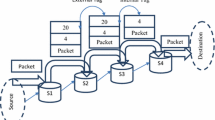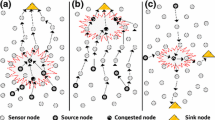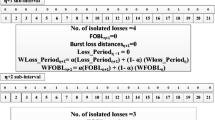Abstract
Routing of critical or unusual packets from source to sink nodes without packet drops is a challenging task in Wireless Sensor Networks (WSNs). Critical or high priority packets carry sensitive data that requires prompt delivery to sink node under emergency situations. Congestion may occur even after setting packet priority and routing high priority packets to sink. In order to preserve critical data reaching sink, priority setting of queue buffer is carried out with traffic load balancing in the MAC and transport layers. The existing congestion control algorithms throw light on rate control and resource control techniques with absence of works done on effectively routing critical packets to sink. Limited works are carried out to route highly sensitive packets from transport layer to sink by bio-inspired packet load distribution. The proposed WH-DTO mechanism enables priority allocation of sensed packets from Cluster Members (CMs) to Cluster Heads (CHs) and from CHs to sink node. The data prioritized packets are routed via relay nodes in clusters by following a bio-inspired mechanism for packet load distribution. The Ozmos technique follows osmosis process to balance packet load from a highly congested node region to a less congested node. Three types of agents operate on nodes namely alert, osmosis and relocation agents to boost even traffic distribution in network nodes. The proposed work is carried on ns3-testbed. WH-DTO is tested with existing algorithms such as EMA-PRDBS, WPDDRC, CSTP-MAC and OH_BAC and observed to achieve 28.5% efficiency in data delivery of high priority packets and 32% increase in network throughput.












Similar content being viewed by others
Data availability
All data generated or analysed during this study are included in this published article.
References
Bohloulzadeh, A., & Rajaei, M. (2020). A survey on congestion control protocols in wireless sensor networks. International Journal of Wireless Information Networks, 27, 365–384.
Muzakkari, B. A., Mohamed, M. A., Kadir, M. F. A., & Mamat, M. (2020). Queue and priority-aware adaptive duty cycle scheme for energy efficient wireless sensor networks. IEEE Access, 8, 17231–17242. https://doi.org/10.1109/ACCESS.2020.2968121
Al-Ghamdi, B., Ayaida, M., & Fouchal, H. (2020). Performance evaluation of scheduling approaches for wireless sensor networks. Wireless Personal Communications, 110, 1089–1108.
Fu, X., Fortino, G., Pace, P., Aloi, G., & Li, W. (2020). Environment-fusion multipath routing protocol for wireless sensor networks. Information Fusion, 53, 4–19. https://doi.org/10.1016/j.inffus.2019.06.001 ISSN 1566-2535.
Mahendran, N., Shankar, S., & Mekala, T. (2020). EMA-PRBDS: Efficient multi-attribute packet rank based data scheduling in wireless sensor networks for real-time monitoring systems. International Journal of Electronics, 107(6), 879–898. https://doi.org/10.1080/00207217.2019.1692244
Swain, S. K., & Nanda, P. K. (2021). Adaptive queue management and traffic class priority based fairness rate control in wireless sensor networks. IEEE Access, 9, 112607–112623.
Onwuegbuzie, I. U., Abd Razak, S., Fauzi Isnin, I., Darwish, T. S. J., & Al-dhaqm, A. (2020). Optimized backoff scheme for prioritized data in wireless sensor networks: A class of service approach. PLoS ONE, 15(8), e0237154.
Hossen, M., & Hanawa, M. (2020). Delay and energy efficient dynamic bandwidth allocation algorithm for hybrid optical and wireless sensor networks. Optical Fiber Technology, 55, 102159. https://doi.org/10.1016/j.yofte.2020.102159 ISSN 1068-5200.
Hamidi-Alaoui, Z., & Alaoui, A. E. B. E. (2019). FM-MAC: A fast-mobility adaptive MAC protocol for wireless sensor networks. Emerging Telecommunications Techmology, 31(6), e3782.
Sarang, S., Stojanović, G. M., Stankovski, S., Trpovski, Ž, & Drieberg, M. (2020). Energy-efficient asynchronous QoS MAC protocol for wireless sensor networks. Wireless Communications and Mobile Computing, 2020, 8860371. https://doi.org/10.1155/2020/8860371
Brocco, A. (2013). The grid, the load and the gradient, a bio-inspired approach to load balancing. Natural Computing, 12, 69–85.
Gamal, M., Rizk, R., Mahdi, H., & Elnaghi, B. E. (2019). Osmotic bio-inspired load balancing algorithm in cloud computing. IEEE Access, 7, 42735–42744.
Janakiraman, S., & Priya, D. (2021). Improved artificial bee colony using monarchy butterfly optimization algorithm for load balancing (IABC-MBOA-LB) in cloud environments. Journal of Network and Systems Management, 29, 39.
Mallikarjuna, B., & Venkata Krishna, P. (2015). OLB: A nature inspired approach for load balancing in cloud computing. Cybernetics and Information Technologies, 15(4), 138–148.
Gowri Prakash, R., Shankar, R., & Duraisamy, S. (2020). FUPA: Future utilization prediction algorithm based load balancing scheme for optimal VM migration in cloud computing. In 4th international conference on inventive systems and control (ICISC) (pp. 638–644).
Kim, J., Lim, J., Park, K., Hong, S. (2021). Fundamentals and application of reverse osmosis membrane processes. In Osmosis engineering (pp. 17–52). Elsevier. ISBN 9780128210161.
Sheba, P., & Kanaga, G. M. (2020). An osmosis-based intelligent agent scheduling framework for cloud bursting in a hybrid cloud. International Journal of Distributed Systems and Technologies (IJDST), 11(3), 1–20.
Swarnakar, S., & Bhattacharya, S. (2021). A bio-inspired and heuristic-based hybrid algorithm for effective performance with load balancing in cloud environment. International Journal of Cloud Applications and Computing (IJCAC), 11(4), 1–21.
Acknowledgements
We acknowledge Suez Canal University, Egypt for supporting this study.
Author information
Authors and Affiliations
Corresponding author
Ethics declarations
Conflict of interest
On behalf of all authors, the corresponding author states that there is no conflict of interest.
Additional information
Publisher's Note
Springer Nature remains neutral with regard to jurisdictional claims in published maps and institutional affiliations.
Rights and permissions
Springer Nature or its licensor holds exclusive rights to this article under a publishing agreement with the author(s) or other rightsholder(s); author self-archiving of the accepted manuscript version of this article is solely governed by the terms of such publishing agreement and applicable law.
About this article
Cite this article
Sangeetha, G., Vijayalakshmi, M. Weighted high priority packet transmission using ozmos bio-inspired mechanism for traffic load distribution (WH-DTO) in WSNs. Wireless Netw 29, 29–45 (2023). https://doi.org/10.1007/s11276-022-03090-x
Accepted:
Published:
Issue Date:
DOI: https://doi.org/10.1007/s11276-022-03090-x




